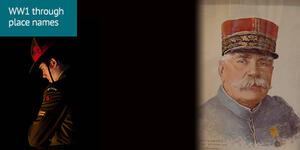
The New Zealand Dawn Service, Le Quesnoy Communal Cemetery Extension 2015 - General Joseph Joffre
A party comprising Hugh Wright and H.E. Hodgkinson made the first ascent of this peak in late November 1914.
By then the First World War had been underway for nearly four months. At a time when many New Zealanders retained strong emotional and practical ties to Britain, the fighting taking place on the Western Front was a matter of considerable public interest. While their fellow climbers J.K. Inglis, E.A. Duncan, and Jack Murrell were labelling the adjacent summit Mount French, after the Commander-in-Chief of the British Expeditionary Force, Wright and Hodgkinson chose to name this peak for the leader of the French Army.
General Joseph Joffre was an unusual choice for such a senior position. Having been a military engineer in France’s far-flung colonies, he had no prior experience of army command or of general staff work. Nevertheless, he was appointed Chief of the French General Staff in 1911.
Joffre’s record during the First World War was somewhat mixed. The first month saw the Allies forced into a chaotic retreat through Belgium and north-eastern France. However, the Germans were prevented from reaching Paris after suffering a strategic defeat at the Battle of the Marne. This engagement was Joffre’s finest hour, as his logistical brilliance and ruthless dismissal of incompetent generals played a key role in stabilising the front. When trench warfare became well established during 1915, the French Army suffered tremendous losses for little discernable gain in Artois and Champagne. A series of blunders during the Battle of Verdun then prompted criticism of Joffre’s leadership, and he was forced to step aside in favour of General Robert Nivelle during December 1916.
Joffre spent the remainder of the War in administrative roles. Promoted to Marshal of France, he led the Military Missions to Romania and the United States, before sitting on the Supreme War Council during 1918.
References:
- First World War.com, ‘Who’s Who – Joseph Joffre’
- New Zealand Geographic Board, ‘New Zealand Gazetteer’
- Reed, A.W., Place Names of New Zealand, Rosedale: Penguin, 2010.